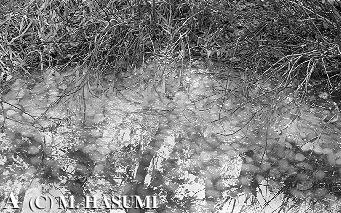

 |  |
(A) A huge mass of egg sacs (more than 500 pairs) of H. nigrescens, deposited in a small pond (approximately 3 m2 in area; 1012 m elevation) at the top of Mt. Haku-san, Muramatsu-machi, Niigata Prefecture, Japan, on 1 June 1986 when breeding activity just ceased. In most of these egg sacs, embryos developed up to a tail-bud stage, and about 10 pairs of egg sacs were soon after deposited. In the pond, 56 males and eight spent females of H. nigrescens were recognized, and many of these males had a completely terrestrial-phase morphology. The dissection of the seven males selected randomly from them exhibited their attenuated testes and vasa deferentia, and no seminal fluid existed in the vasa. At the time of examination, there was no snow around the pond.
(B) An egg sac of H. lichenatus, found among more than 500 pairs of egg sacs of H. nigrescens. Fifteen embryos, having a stage of blastula, in the egg sac all died out by a late neural-fold stage. This resulted from the event that spermatozoa of male H. nigrescens in high density were incidentally fertilized on eggs in one egg sac deposited by a female of H. lichenatus (another egg sac was not found), and is evidence for a postmating isolating mechanism what embryos die during early development in the hybridization between sympatric Hynobius species.
Hynobius lichenatus is distributed only around the "Jiko-ji" Temple (160 m elevation) at the foot of Mt. Haku-san.